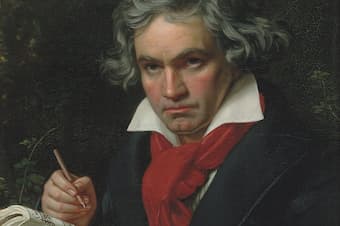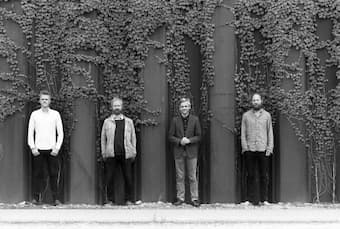
The Danish String Quartet © Caroline Bittencourt
The award winning Danish String Quartet performed all sixteen Beethoven String Quartets from November 5-11 in an astonishing six programs—a belated celebration of Beethoven’s 250th birthday worth waiting for. The ensemble was originally scheduled to perform the works in a three-week residency planned for May of 2020. The Schubert Club of Minnesota pursued rescheduling the quartet and at long last in November of 2021 they came to town, for a week. The musicians dazzled with their brilliant technique, exquisite finesse, and exceptionally beautiful interpretations, never letting on what a marathon effort it was.
Danish Quartet performs Op. 132 Allegro Movement for BBC
These works, from three distinct periods of Beethoven’s life, reflect Beethoven’s development as a composer and brilliant innovator. Considered the epitome of his compositions, program annotator Michael Adams confirmed, “The 16 string quartets of Beethoven are to chamber music what the plays of Shakespeare are to drama, what Rembrandt is to art, and what Wagner is to opera.”
The six quartets Opus 18 written when Beethoven was between 27 to 30 years old, harken back to the quartets of Mozart and Haydn. They are classical in style—lively, enchanting, and more conventional, but not light-weight, as they hint at the genre-expanding music of his later quartets. The scherzo of the Op. 18 in F is sprightly but Beethoven surprises us with brusque sforzandos, the quick tempo, and the turbulent “B” section in a key full of flats and flamboyant scales.
Ludwig van Beethoven: String Quartet No. 1 in F Major, Op. 18, No. 1 – III. Scherzo: Allegro molto (Miró Quartet)

Beethoven with the manuscript for Missa Solemnis (detail; 1820),
Joseph Karl Stieler. © Beethoven-Haus Bonn
From 1803-1814, Beethoven’s middle period, he grapples with the fact that he can no longer pursue a performing career due to his increasing deafness. Despite his heartbreaking struggles he composed magnificent works including Symphonies No. 5 and No. 3 The Eroica, and his Piano Sonata No. 23 the Appassionata. The three Opus 59 quartets are named after one of Beethoven’s patrons Count Razumovsky, a fine cellist, and the Russian ambassador to Vienna. There are vestiges of Russian melodies in these works and typical Beethovenian surprises such as seemingly abrupt changes of keys and dynamics, misplaced accents, and denser sonorities than audiences had heard before. No wonder musicians said and critics wrote, “incomprehensible” “unplayable” “the work of a madman.” But Beethoven knew better. He insisted they were works for the future. The awe-inspiring slow movement of Op. 59. No. 2 marked Molto Adagio and “with great sentiment” depicts the night sky, the young lovers Romeo and Juliet parting forever.
Ludwig van Beethoven: String Quartet No. 8 in E Minor, Op. 59, No. 2, “Rasumovsky” – II. Molto adagio (Budapest String Quartet)
In 1809 the Opus 74 so-called Harp quartet followed—nicknamed due to Beethoven’s use of pizzicato in the first movement of the piece. This is the year Beethoven composed the masterful Emperor Piano Concerto No. 5 in E-flat Major, and finally achieved some financial stability.
The Opus 95 quartet in F minor, the most condensed quartet marked “Serioso”, begins to explore the deep expression, stormy melancholy, and revolutionary style of the late quartets. The arresting opening leaves no doubt as to Beethoven’s disposition. After completing the Op. 95 quartet Beethoven, now aged 40, not only stopped writing string quartets for fourteen years, he wrote very little music for almost a year. His life had taken a turn for the worse—he was isolated from friends and family due to his deafness, he had serious and painful digestive problems, and his shaky finances, let alone the political turmoil of the time and his contentious custody battle for his nephew Karl, led to Beethoven’s angry demeanor.
Ludwig van Beethoven: String Quartet No. 11 in F Minor, Op. 95, “Serioso” – I. Allegro con brio (Emerson String Quartet)
The five late quartets written from 1824-1827, Opus 127, 130, 131, 132, and 135 are transcendent and profound works. Of the titanic seven-movement Quartet 14, Op. 131 Schubert said, “After this, what is left for us to compose?”
Ludwig van Beethoven: String Quartet No. 14 in C-Sharp Minor, Op. 131 – VII. Allegro (Tokyo String Quartet)

© Caroline Bittencourt
Beethoven thought better of ending the Op. 130 quartet with the massive and complex Grosse Fugue. He substituted a Cavatina. The Grosse Fugue was published after Beethoven’s death as Opus 133, to be performed separately, but musicians sometimes play it as it was intended. The Danish quartet played all six gigantic movements—a colossal undertaking.
The Danish quartet conveyed the profundity of these works with panache. I reveled in their extensive palette of sound colors, oftentimes not using any vibrato at all to indicate a bleak and desolate outlook, employing unique bowings to vary the timbre, articulation, quality of sound, and dynamics, and oftentimes pushing to breakneck tempos. How they interact with each other is like a conversation between the players and the goal is to communicate a unified interpretation. The four players attained a balance between the intensely individual and virtuosic voices—melding their sounds achieved over many long hours of rehearsal. Likely they spend more time together than with their families!
The group has such an impeccably unified approach to the music, and is so evenly matched that the two violinists exchange places, sometimes taking turns playing the first violin part.
Beethoven became very ill while composing the quartet No. 15 in A Minor Op. 132. Composed in 1825 just two years before his death, he subtitled the third movement to suggest confronting his own mortality.
The first movement, Assai sostenuto (very sustained) – Allegro, opens with the lone voice of the cello playing a four-note motif—a sixth separating two half-steps, G#–A–F–E. The motif appears in the entire work. This challenging movement suggests the dramatic, turbulent, and exultant journey of the entire quartet. The Molto Adagio movement, played almost without vibrato transports us to a higher plane.
The sheer scope of the late quartets, so profound in construction and in expression, has listeners and performers alike continually discovering new dimensions to these works, even 250 years after his birth. The music of Beethoven, especially the string quartets, has lessons for us today, of overcoming crisis, of spirituality, and of every human experience.
For more of the best in classical music, sign up to our E-Newsletter
Danish Quartet performs Op. 132 Molto Adagio Movement
